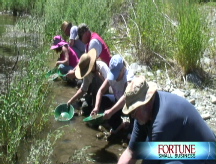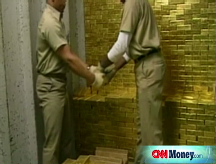'New 49'ers' seek California gold
An entrepreneur lures aspiring miners to an old gold-rush town.
 |
| At the bottom of a pan, flecks of gold shine through the sediment. |
HAPPY CAMP, CALIF. (Fortune Small Business) -- The northern California town of Happy Camp (pop. 1,000) was founded in 1850 when an estimated 15,000 people converged here, pitching tents and building rickety lean-tos. They came to work on a nearby stretch of the Klamath River dubbed the Million Dollar Mile because, legend has it, that was the value of the gold extracted on an average day.
While not every prospector struck it rich, Happy Camp earned its name from the variety of diversions available to both failed and successful miners: gambling, hookers, whiskey, and opium. What happened in Happy Camp stayed in Happy Camp.
Today the town features zero stoplights, only a few businesses (Bigfoot 24-Hour Towing is one), and a handful of houses, mostly hidden among the pines. I'm here to attend a beginner's prospecting weekend, led by an enterprising former Navy SEAL named Dave McCracken.
I check into the Forest Lodge Motel on Friday evening. Early the next morning I present myself at the Lions Hall, the only room in town large enough for McCracken's opening seminar on prospecting techniques. The roughly 100 attendees hail from as far away as Hawaii and Virginia. Among them are entrepreneurs, a railroad engineer, a computer programmer, several retirees, and a contingent of career gold diggers, mostly locals, some of whom work for one or more of McCracken's prospecting enterprises.
The day after Christmas 1979, following a four-year tour of duty, McCracken succumbed to the gold bug. Along with two partners, he headed for the Klamath River in Northern California. The partners lasted just two months. McCracken stayed on, living in a tent for the next three years. On his best days he recovered a few pennyweights of gold (worth roughly $100 back then). For a while he subsisted on an annual income of less than $3,000 - and lots of beans. Over time he won the trust of some old-timers who still worked the region. They taught him their tricks.
Now 54, McCracken has built a Happy Camp mini-empire. He owns the town's prospecting store, where shoppers can purchase anything from a tiny gold-display vial (50 cents) to a big, unwieldy piece of prospecting equipment called a dredge ($4,550).
He is the author of five books on prospecting and has produced three DVDs. He has also staked mineral claims along 70 miles of the Klamath. McCracken pays annual fees of about $50,000 to the U.S. Forest Service to maintain those rights. His stakes enable his biggest moneymaker, a prospecting club called the New 49'ers. For a one-time, $3,500 fee, members can prospect on McCracken's claims, keeping any gold they find. He launched the New 49'ers in 1985 with 500 members and says he now has more than 2,000.
McCracken explains what we can expect during our prospecting initiation. After panning to find promising locations for gold, we'll return to work them hard. The weekend will culminate in a split of the gold among all 100 participants. He stresses that although everyone will find some gold, it's unlikely that anyone will find much. Still, McCracken has a tough time containing himself.
"Hardly anything compares to finding your first gold," he says. "Even if it's just a tiny fleck - it's pure euphoria."
Sifting sediment
At noon on Saturday our group heads over to Savage Rapids, on the Klamath River. The plan is to work a gravel bar in the flat plain between the water and the woods. It's considered an ideal panning location because the river often deposits gold here when it overflows its banks.
Gold panning involves two steps, one land-based and the other water-based. McCracken demonstrates the technique, which hasn't changed since 1849: Using a spade, he flicks away the top layer of gravel, then digs into the rich, wet silt underneath, filling his pan. He walks to the river's edge and dips his pan in the water. Moving it around, he separates out liquid and lighter bits of sediment. After about five minutes he holds out his pan for us to inspect. There's some water, a lot of iron-laden black sand, and a few tiny flecks of gold.
Panning proves a lot harder than McCracken makes it look. Squatting in the chilly Klamath, the pan heavy with dirt and water, I struggle to keep my balance. After 20 minutes of sloshing, I reach the bottom of the pan. To my amazement, I see two minute, glittering specks.
Saturday night we return to the Lions Hall for a potluck dinner of beef stew, corn bread, and potato salad. Country music twangs over the speakers. As the evening draws on, both visitors and locals relax. One after another, the seasoned prospectors reach into their dungaree pockets and show their treasures, special nuggets that they carry in grubby envelopes and little glassine bags. Each lump tells a story. Some are prized for their unusual shape, others for weight and purity.
On Sunday morning I return to the Klamath, where McCracken and his crew are setting up four gas-powered machines, known as high-bankers, in the most promising spots from the day before. These robotic gold pans process dirt much faster than humans can. Drawing river water through a long hose, the high-banker sorts and agitates, spitting out the lighter sediments. At the base of the machine, the heavy stuff (gold, black sand, bits of lead) comes to rest in a removable tray. This weighty yield is then run through a mechanism that separates gold from other heavy material.
Nuggets and flakes
My job is to dig with a shovel and fill buckets with dirt. Other prospectors haul the buckets and dump the contents into the high-bankers to be filtered. We work in the grueling heat from 10 A.M. to noon, when McCracken announces we have processed enough soil. With much ceremony he withdraws the trays from the high-bankers. I can see numerous metallic glints, many of them golden. The next step is to run this yield through another machine that washes away the dross and leaves the gold.
Back at the Lions Hall, the entire day's take is spread out on a single piece of letter-sized paper. McCracken passes a magnet over the sheet. It attracts iron-rich black sand, leaving behind the nonmagnetic gold.
He then pours the precious metal onto a scale. The room falls silent in anticipation. McCracken fiddles with the slider weights and then announces, "We got an ounce and a half of gold - not bad for two days' work." Our haul includes 13 small nuggets among the flakes and flecks. We draw numbered poker chips from a can. The first 13 people will get a nugget. I draw No. 86.
As I line up to claim my small share of gold dust, I run into fellow prospector Linda Wilkinson. Along with her husband, Wilkinson owns Jump Organics, a soap manufacturer in Albany, Ore. She examines her little vial, agitating some $13.50 in glittering flakes. "I won't be retiring on this, but I had a blast," she says, grinning. ![]()
-
The Cheesecake Factory created smaller portions to survive the downturn. Play
-
A breeder of award-winning marijuana seeds is following the money and heading to the U.S. More
-
Most small businesses die within five years, but Amish businesses have a survival rate north of 90%. More
-
The 10 most popular franchise brands over the past decade -- and their failure rates. More
-
These firms are the last left in America making iconic products now in their twilight. More













